中考英语语法考点总结——时态(共37张PPT)
文档属性
| 名称 | 中考英语语法考点总结——时态(共37张PPT) |  | |
| 格式 | ppt | ||
| 文件大小 | 3.4MB | ||
| 资源类型 | 试卷 | ||
| 版本资源 | 通用版 | ||
| 科目 | 英语 | ||
| 更新时间 | 2022-04-10 18:54:19 | ||
图片预览

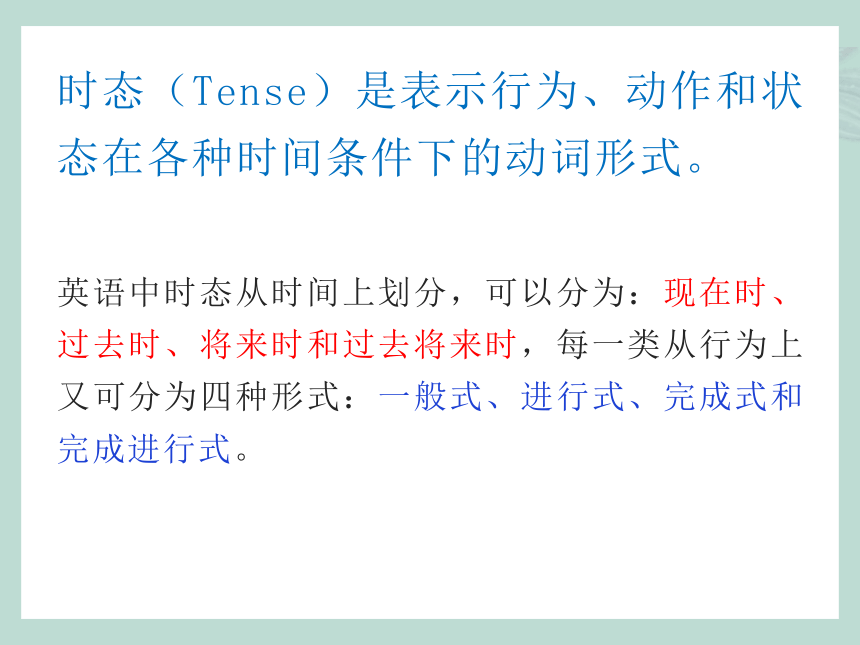
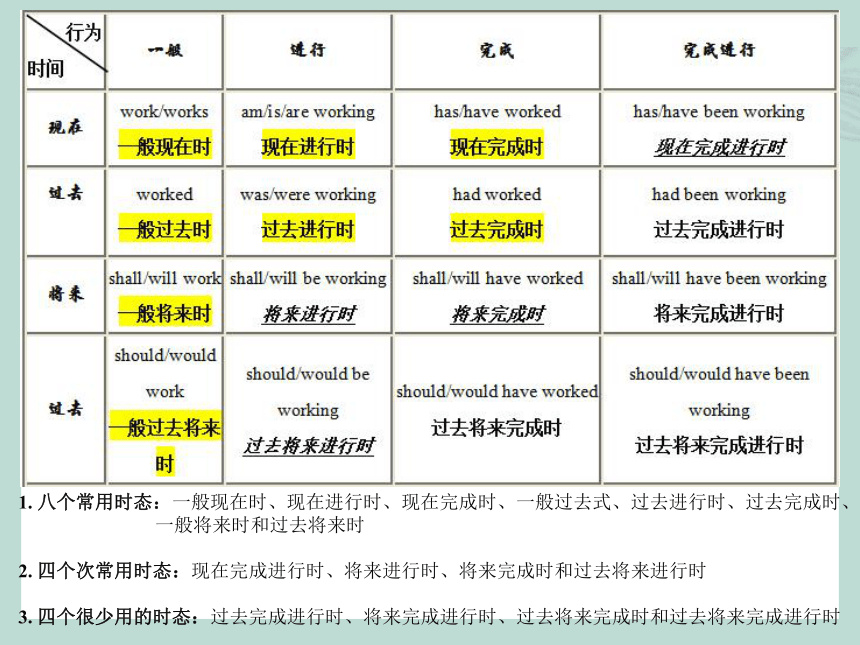

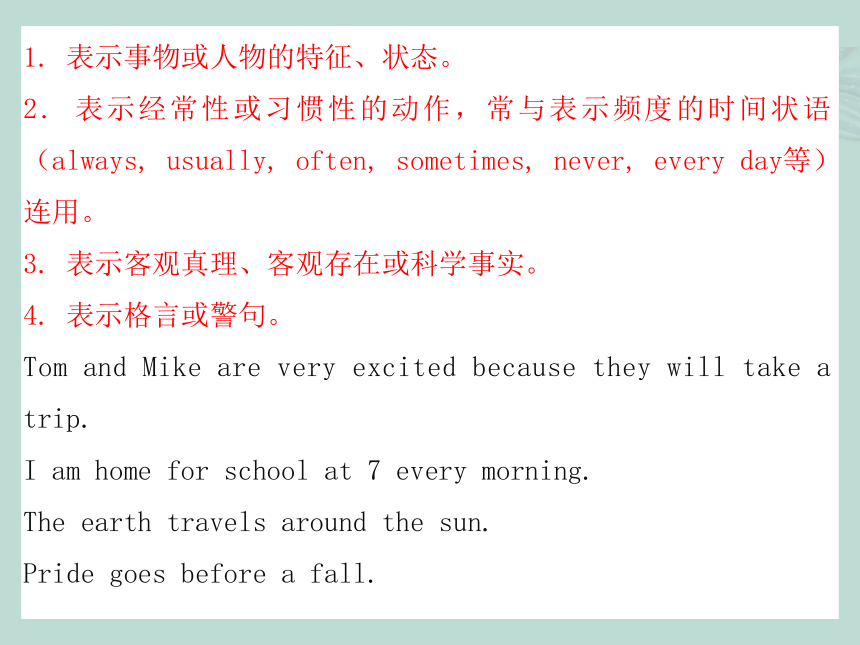

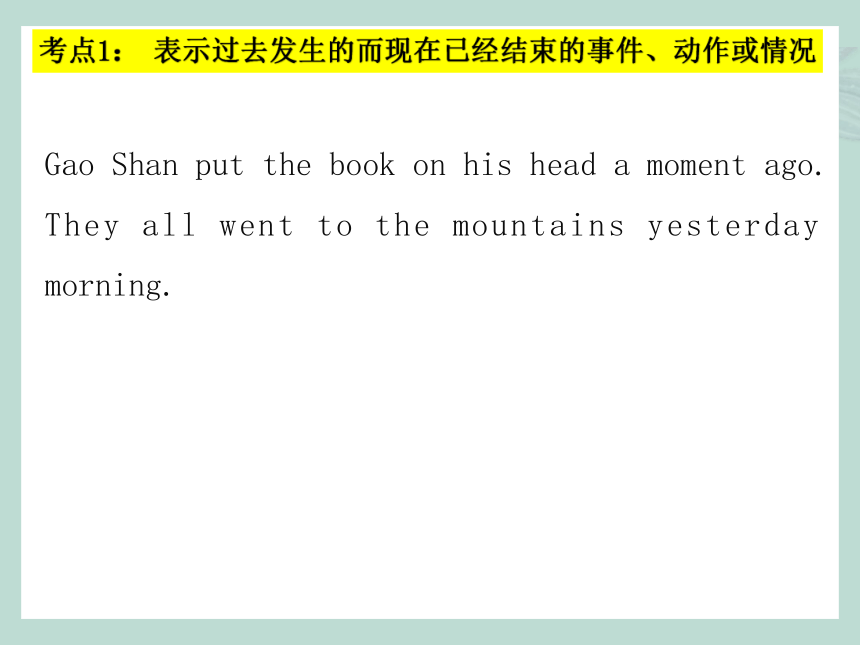
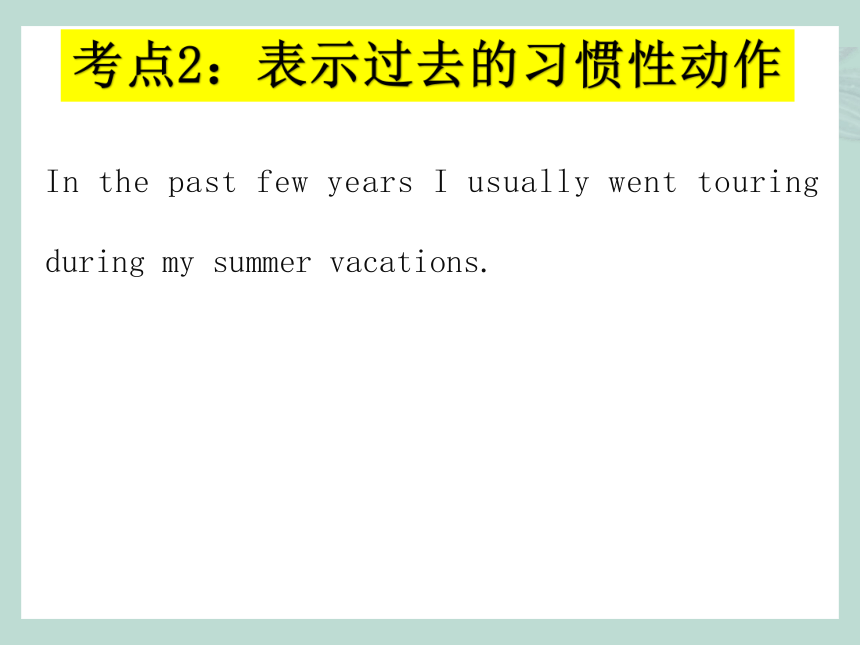

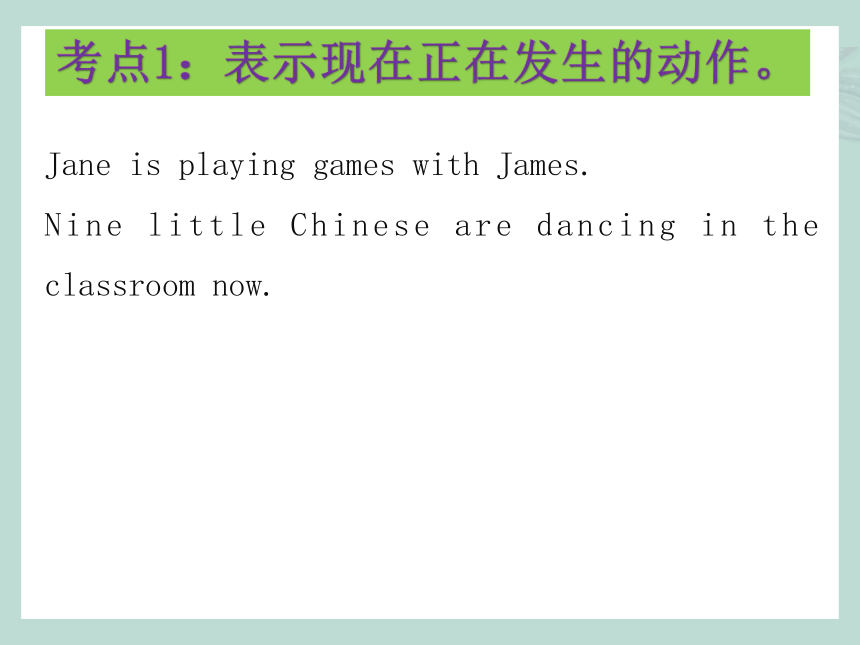
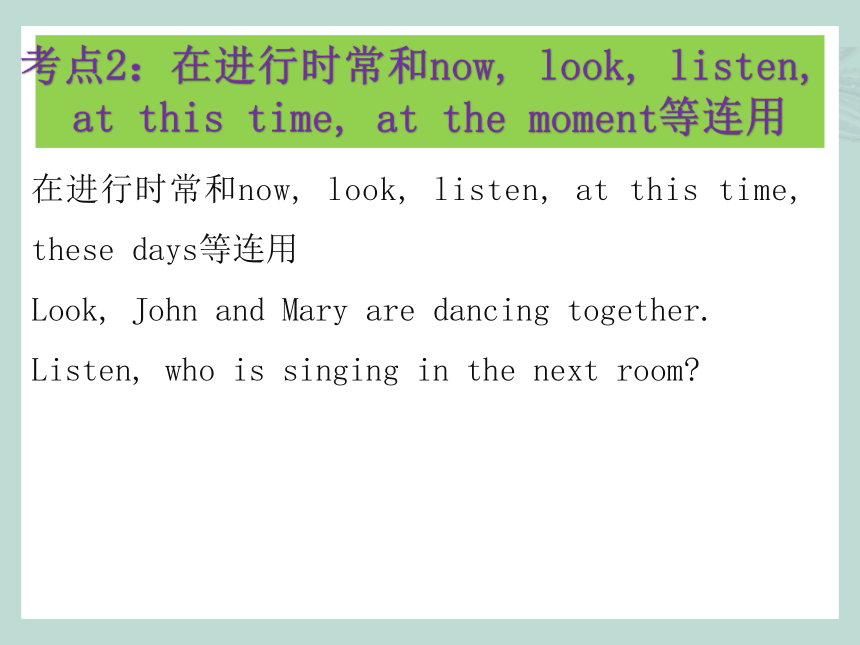
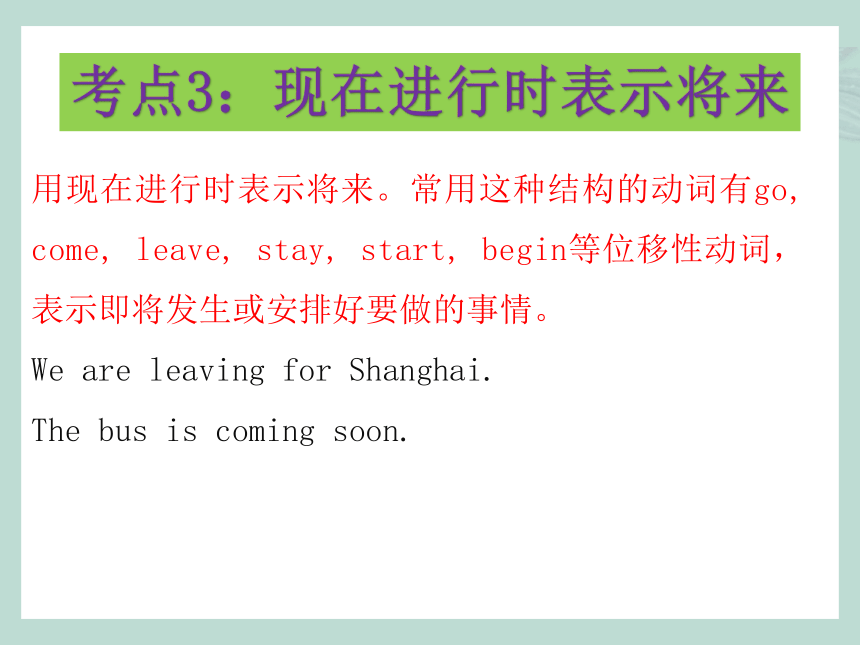
文档简介
(共37张PPT)
时态
时态(Tense)是表示行为、动作和状态在各种时间条件下的动词形式。
英语中时态从时间上划分,可以分为:现在时、过去时、将来时和过去将来时,每一类从行为上又可分为四种形式:一般式、进行式、完成式和完成进行式。
1. 八个常用时态:一般现在时、现在进行时、现在完成时、一般过去式、过去进行时、过去完成时、一般将来时和过去将来时
2. 四个次常用时态:现在完成进行时、将来进行时、将来完成时和过去将来进行时
3. 四个很少用的时态:过去完成进行时、将来完成进行时、过去将来完成时和过去将来完成进行时
1. 表示事物或人物的特征、状态。
2. 表示经常性或习惯性的动作,常与表示频度的时间状语(always, usually, often, sometimes, never, every day等)连用。
3. 表示客观真理、客观存在或科学事实。
4. 表示格言或警句。
Tom and Mike are very excited because they will take a trip.
I am home for school at 7 every morning.
The earth travels around the sun.
Pride goes before a fall.
考点1: 表示过去发生的而现在已经结束的事件、动作或情况
Gao Shan put the book on his head a moment ago.
They all went to the mountains yesterday morning.
考点2:表示过去的习惯性动作
In the past few years I usually went touring during my summer vacations.
考点1:表示现在正在发生的动作。
Jane is playing games with James.
Nine little Chinese are dancing in the classroom now.
考点2:在进行时常和now, look, listen,
at this time, at the moment等连用
在进行时常和now, look, listen, at this time, these days等连用
Look, John and Mary are dancing together.
Listen, who is singing in the next room
考点3:现在进行时表示将来
用现在进行时表示将来。常用这种结构的动词有go, come, leave, stay, start, begin等位移性动词,表示即将发生或安排好要做的事情。
We are leaving for Shanghai.
The bus is coming soon.
1、一般将来时基本结构1:主语+shall/will+动词原形+其他成分,shall用于第一人称,will可用于所有人称。
Tom will be a middle school student next year.
I will clean the classroom this afternoon.
2、一般将来时基本结构2:主语+am/is/are going to +动词原形+其他成分,表示事先经过考虑,安排,计划要做的事情,或者根据目前某种迹象判断某事非常有可能发生。
They are going to clean the classroom this weekend.
Look at the black clouds, it is going to rain.
3、will与be going to 的区别:be going to 指的是计划打算,并有迹象的推测,而will表示客观的将来。
Fish will die out of water.
There are black blouds in the sky. It is going to rain.
考点1:过去进行时的定义与结构。
① 定义:过去完成时表示过去某个时间点正在发生的动作或存在的状态。
② 结构:was/were doing
I was having a meeting at eight yesterday.
The students were reading books loudly when the the teacher came in.
考点2:常与过去进行时连用的时间状语
过去完成时的时间状语常为表示过去某一点时间的短语或者句子:at nine yesterday, at that time, when I arrived…
At three yesterday afternoon, the farmers were working on the farm.
Tom's mother was cooking dinner when Tom went into the kitchen.
考点3:过去进行时的用法
① 表示过去某时正在发生的动作。
I was reading a newspaper at nine o'clock yesterday evening.
② 表示过去某段时间持续的动作。
They were building a dam last spring.
③ 表示与过去某个动作同时发生的动作,常见于从句中。
I was doing my homework while my mother was cooking.
④ 同always,forever等频率副词连用表示各种感彩。
She was always complaining about her husband.
考点1: 现在完成时的结构
现在完成时是由“助动词 have(has)+动词的过去分词”构成。助动词说明该谓语是属于现在时范围。它和主语的人称、数要保持一致。过去分词是主要的谓语动词,说明句子的意义。
He has already finished his homework.
He hasn't finished his homework yet.
---Has he finished his homework yet
---Yes, he has./ No, he hasn't.
考点2: 现在完成时的用法
① 表过去发生的某一动作对现在造成的影响或结果。
---Would you like some bread
---No, thanks. I have had my breakfast.
(对现在的影响:不饿)
---Why don't you drive to your office
---Because my car has broken.
(对现在的影响:车没办法开了)
② 表示从过去开始一直持续到现在, 也许还会继续下去的动作或状态。
He has studied English for 6 years.
Mary has been busy since she came back from Hangzhou.
考点3: 常连用的时间状语
① 用副词already和yet。already一般用于肯定句中,yet一般用于否定句和疑问句中。
We have already finished our homework.
They haven't finished their homework yet.
② 用ever “曾经”和never“从未”。它们多用于否定或疑问句中。
Have you ever been to the Great Wall
I have never been to the Great Wall.
③ 用表示到说话为止的过去时间状语,如just, before, up to now, so far, until now, in the past few years等。
I have seen her before, but I can not remember where.
He has been there three times in the last few days.
④ 用for+一段时间,since+时间点。
I've lived here for 15 years.
I've lived here since 15 years ago.
Mr. Green has worked here since he came to China.
“for+一段时间”和“since+时间点”都是表示一段时间的状语,表示动作或状态从某一时刻开始,一直持续到现在。
常见的短暂性动词转换为延续性动词:
arrive→be here begin(start)→be on
die→be dead come back→be back
leave→be away
fall ill(sick,asleep)→be ill(sick,asleep)
get up→be up go out→be out
finish→be over put on→wear 或be on
open→be open
join→be in或 be a member of
close→be closed go to school→be a student
borrow→keep buy→have
catch a cold)→have a cold
考点4: have been in 、have been to与have gone to的区别
① have been in 表示“在某地(多长时间)”,常与表示一段时间的状语连用。
Mr. Brown has been in Shanghai for three days.
② have been to表示“曾经去过某地”,现在已经不在那里了,可与just, ever, never等连用。
Mary has never been to the Great Wall.
They have been to that village several times.
③ have gone(to)表示“ 到某地去了”,表示到了某地或正在去某地的途中。总之,说话时该人不在现场,常用于第三人称。
---Where is Tom
---He has gone to the bookshop.
考点5: 现在完成时与一般过去时的区别
① have been in 表示“在某地(多长时间)”,常与表示一段时间的状语连用。
Mr. Brown has been in Shanghai for three days.
② have been to表示“曾经去过某地”,现在已经不在那里了,可与just, ever, never等连用。
Mary has never been to the Great Wall.
They have been to that village several times.
③ have gone(to)表示“ 到某地去了”,表示到了某地或正在去某地的途中。总之,说话时该人不在现场,常用于第三人称。
---Where is Tom
---He has gone to the bookshop.
考点1: 过去完成时的定义及构成
过去完成时表示在过去某一时间或动作之前已经发生或完成了的动作,即“过去的过去( past-in-the-past )”。
They had already had breakfast before they arrived at the hotel.
He didn't go to bed until he had finished he work.
考点2: 过去完成时的用法
① 过去完成时表示一个动作或状态在过去某一动作之前已经完成或结束。
When I woke up, it had stopped raining.
He had left when I arrived.
② 过去完成时表示一个动作或状态在过去某一时间之前已经完成或结束。
Before she came to China, Amy had taught English in a middle school for about five years.
③ 过去完成时表示某一动作或状态在过去某时之前已经开始,一直延续到这一过去时间,而且动作尚未结束,仍然有继续下去的可能。
By the end of last year, my father had worked in the factory for twenty years.
By six o'clock he had worked eleven hours.
过去将来时表示从过去某时看将来要发生的动作或存在的状态.是在某一过去时之后发生的动作.我们可以理解为它是"立足于过去,着眼于未来"的一种时态。
构成:would/should do
Li Ming said that you would be happy if you heard from me.
He said that he was going to have a walk with his mother.
THANK YOU
时态
时态(Tense)是表示行为、动作和状态在各种时间条件下的动词形式。
英语中时态从时间上划分,可以分为:现在时、过去时、将来时和过去将来时,每一类从行为上又可分为四种形式:一般式、进行式、完成式和完成进行式。
1. 八个常用时态:一般现在时、现在进行时、现在完成时、一般过去式、过去进行时、过去完成时、一般将来时和过去将来时
2. 四个次常用时态:现在完成进行时、将来进行时、将来完成时和过去将来进行时
3. 四个很少用的时态:过去完成进行时、将来完成进行时、过去将来完成时和过去将来完成进行时
1. 表示事物或人物的特征、状态。
2. 表示经常性或习惯性的动作,常与表示频度的时间状语(always, usually, often, sometimes, never, every day等)连用。
3. 表示客观真理、客观存在或科学事实。
4. 表示格言或警句。
Tom and Mike are very excited because they will take a trip.
I am home for school at 7 every morning.
The earth travels around the sun.
Pride goes before a fall.
考点1: 表示过去发生的而现在已经结束的事件、动作或情况
Gao Shan put the book on his head a moment ago.
They all went to the mountains yesterday morning.
考点2:表示过去的习惯性动作
In the past few years I usually went touring during my summer vacations.
考点1:表示现在正在发生的动作。
Jane is playing games with James.
Nine little Chinese are dancing in the classroom now.
考点2:在进行时常和now, look, listen,
at this time, at the moment等连用
在进行时常和now, look, listen, at this time, these days等连用
Look, John and Mary are dancing together.
Listen, who is singing in the next room
考点3:现在进行时表示将来
用现在进行时表示将来。常用这种结构的动词有go, come, leave, stay, start, begin等位移性动词,表示即将发生或安排好要做的事情。
We are leaving for Shanghai.
The bus is coming soon.
1、一般将来时基本结构1:主语+shall/will+动词原形+其他成分,shall用于第一人称,will可用于所有人称。
Tom will be a middle school student next year.
I will clean the classroom this afternoon.
2、一般将来时基本结构2:主语+am/is/are going to +动词原形+其他成分,表示事先经过考虑,安排,计划要做的事情,或者根据目前某种迹象判断某事非常有可能发生。
They are going to clean the classroom this weekend.
Look at the black clouds, it is going to rain.
3、will与be going to 的区别:be going to 指的是计划打算,并有迹象的推测,而will表示客观的将来。
Fish will die out of water.
There are black blouds in the sky. It is going to rain.
考点1:过去进行时的定义与结构。
① 定义:过去完成时表示过去某个时间点正在发生的动作或存在的状态。
② 结构:was/were doing
I was having a meeting at eight yesterday.
The students were reading books loudly when the the teacher came in.
考点2:常与过去进行时连用的时间状语
过去完成时的时间状语常为表示过去某一点时间的短语或者句子:at nine yesterday, at that time, when I arrived…
At three yesterday afternoon, the farmers were working on the farm.
Tom's mother was cooking dinner when Tom went into the kitchen.
考点3:过去进行时的用法
① 表示过去某时正在发生的动作。
I was reading a newspaper at nine o'clock yesterday evening.
② 表示过去某段时间持续的动作。
They were building a dam last spring.
③ 表示与过去某个动作同时发生的动作,常见于从句中。
I was doing my homework while my mother was cooking.
④ 同always,forever等频率副词连用表示各种感彩。
She was always complaining about her husband.
考点1: 现在完成时的结构
现在完成时是由“助动词 have(has)+动词的过去分词”构成。助动词说明该谓语是属于现在时范围。它和主语的人称、数要保持一致。过去分词是主要的谓语动词,说明句子的意义。
He has already finished his homework.
He hasn't finished his homework yet.
---Has he finished his homework yet
---Yes, he has./ No, he hasn't.
考点2: 现在完成时的用法
① 表过去发生的某一动作对现在造成的影响或结果。
---Would you like some bread
---No, thanks. I have had my breakfast.
(对现在的影响:不饿)
---Why don't you drive to your office
---Because my car has broken.
(对现在的影响:车没办法开了)
② 表示从过去开始一直持续到现在, 也许还会继续下去的动作或状态。
He has studied English for 6 years.
Mary has been busy since she came back from Hangzhou.
考点3: 常连用的时间状语
① 用副词already和yet。already一般用于肯定句中,yet一般用于否定句和疑问句中。
We have already finished our homework.
They haven't finished their homework yet.
② 用ever “曾经”和never“从未”。它们多用于否定或疑问句中。
Have you ever been to the Great Wall
I have never been to the Great Wall.
③ 用表示到说话为止的过去时间状语,如just, before, up to now, so far, until now, in the past few years等。
I have seen her before, but I can not remember where.
He has been there three times in the last few days.
④ 用for+一段时间,since+时间点。
I've lived here for 15 years.
I've lived here since 15 years ago.
Mr. Green has worked here since he came to China.
“for+一段时间”和“since+时间点”都是表示一段时间的状语,表示动作或状态从某一时刻开始,一直持续到现在。
常见的短暂性动词转换为延续性动词:
arrive→be here begin(start)→be on
die→be dead come back→be back
leave→be away
fall ill(sick,asleep)→be ill(sick,asleep)
get up→be up go out→be out
finish→be over put on→wear 或be on
open→be open
join→be in或 be a member of
close→be closed go to school→be a student
borrow→keep buy→have
catch a cold)→have a cold
考点4: have been in 、have been to与have gone to的区别
① have been in 表示“在某地(多长时间)”,常与表示一段时间的状语连用。
Mr. Brown has been in Shanghai for three days.
② have been to表示“曾经去过某地”,现在已经不在那里了,可与just, ever, never等连用。
Mary has never been to the Great Wall.
They have been to that village several times.
③ have gone(to)表示“ 到某地去了”,表示到了某地或正在去某地的途中。总之,说话时该人不在现场,常用于第三人称。
---Where is Tom
---He has gone to the bookshop.
考点5: 现在完成时与一般过去时的区别
① have been in 表示“在某地(多长时间)”,常与表示一段时间的状语连用。
Mr. Brown has been in Shanghai for three days.
② have been to表示“曾经去过某地”,现在已经不在那里了,可与just, ever, never等连用。
Mary has never been to the Great Wall.
They have been to that village several times.
③ have gone(to)表示“ 到某地去了”,表示到了某地或正在去某地的途中。总之,说话时该人不在现场,常用于第三人称。
---Where is Tom
---He has gone to the bookshop.
考点1: 过去完成时的定义及构成
过去完成时表示在过去某一时间或动作之前已经发生或完成了的动作,即“过去的过去( past-in-the-past )”。
They had already had breakfast before they arrived at the hotel.
He didn't go to bed until he had finished he work.
考点2: 过去完成时的用法
① 过去完成时表示一个动作或状态在过去某一动作之前已经完成或结束。
When I woke up, it had stopped raining.
He had left when I arrived.
② 过去完成时表示一个动作或状态在过去某一时间之前已经完成或结束。
Before she came to China, Amy had taught English in a middle school for about five years.
③ 过去完成时表示某一动作或状态在过去某时之前已经开始,一直延续到这一过去时间,而且动作尚未结束,仍然有继续下去的可能。
By the end of last year, my father had worked in the factory for twenty years.
By six o'clock he had worked eleven hours.
过去将来时表示从过去某时看将来要发生的动作或存在的状态.是在某一过去时之后发生的动作.我们可以理解为它是"立足于过去,着眼于未来"的一种时态。
构成:would/should do
Li Ming said that you would be happy if you heard from me.
He said that he was going to have a walk with his mother.
THANK YOU
同课章节目录
- 词法
- 名词
- 动词和动词短语
- 动词语态
- 动词时态
- 助动词和情态动词
- 非谓语动词
- 冠词
- 代词
- 数词和量词
- 形容词副词及其比较等级
- 介词和介词短语
- 连词和感叹词
- 构词法
- 相似、相近词比较
- 句法
- 陈述句
- 一般疑问句和否定疑问句
- 特殊疑问句及选择疑问句
- 反意疑问句
- 存在句(There be句型)
- 宾语从句
- 定语从句
- 状语从句
- 主谓一致问题
- 简单句
- 并列句
- 复合句
- 主谓一致
- 主、表语从句
- 名词性从句
- 直接引语和间接引语
- 虚拟语气
- 感叹句
- 强调句
- 倒装句
- 祈使句
- 句子的成分
- 句子的分类
- 题型专区
- 单项选择部分
- 易错题
- 完形填空
- 阅读理解
- 词汇练习
- 听说训练
- 句型转换
- 补全对话
- 短文改错
- 翻译
- 书面表达
- 任务型阅读
- 语法填空
- 其他资料
